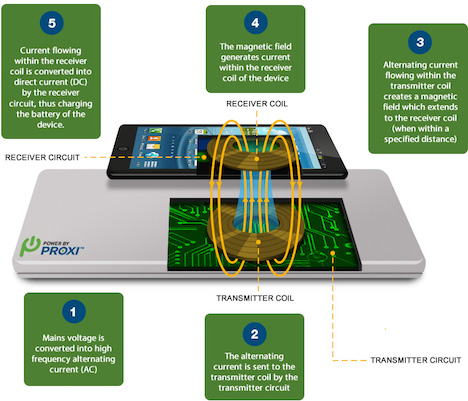History of Computers - Wireless Charging
Introduction
While the materials and components used for inductive charging, or wireless charging, have been available for quite a while, the application of this process to everyday devices has only sprung up in the past couple of years. Also, the invention of inductive charging is not credited to any single person. [1] Wireless power was first attempted by Nikola Tesla who believed that a whole city could be powered by a few massive tesla towers.[1]

Overview
Wireless charging is a highly convenient process by which one can charge multiple devices quickly and safely. As of late, wireless charging has been implemented into a wide variety of devices, from toothbrushes to electric cars. Wireless charging utilizes electromagnetic fields between two coils of wire to efficiently transfer energy from a transmitting source coil to the receiving device coil as a means of wirelessly charging the battery in the receiving device. While the two coils work better when closer together, the process of wireless charging does not actually require any physical connection. [2]
How It Works
As mentioned above, wireless charging takes advantage of the principle magnetic resonance, which simply is the process of transmitting electrical current between two coils, one in the charger and one in the device, to induce an electromagnetic field. The image below will aid in understanding this process. First, the source, or charger, has some voltage that is converted into high frequency alternating current. Next, this current is run through the transmitting coil inside the charger. Since the current is alternating, it produces a magnetic field that can be transferred to and received by a receiving coil, which is in the device being charged. In the receiving coil, the induced magnetic field is converted back into an alternating current and then back into direct current as a means to charge the device. But, keep in mind, the relative positions and distances between the two coils will ultimately be responsible for charging efficiency, so the farther away the charging device gets, the less efficient until it eventually stops charging. [3]

Significance
The significance of wireless charging is that it not only has provided a higher efficiency method of charging electric devices, but it also is much more convenient and has a lot of potential. In the near future, wireless charging parking spots could be a critical part of city infrastructure as the move for more electric and hybrid cars surges. These spots would be able to charge any electric car that has a standardized receiving coil inside of it, thus making eliminating the need to have to charge your car at a station for long periods of time or even worse to have to purchase a charging station of your own. Even more advanced, cities abroad are working on public transportation that charges itself whilst running, essentially a road that charges the vehicle. While this is extremely expensive, it could also be highly effective in the worldwide decline of carbon-base vehicle emissions. However, all in all, the invention of wireless charging compares quite similarly to many other inventions, it provides a more efficient and more convenient way of doing things.
References
https://powerbyproxi.com/wireless-charging/